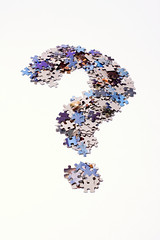 I make no secret of the fact that I like reading (what you might call) “ideas books”. Currently, I’m reading the latest Malcolm Gladwell book, What The Dog Saw, which is chock-full of ideas. Every chapter is an essay he’d previously written for the New Yorker magazine.
I make no secret of the fact that I like reading (what you might call) “ideas books”. Currently, I’m reading the latest Malcolm Gladwell book, What The Dog Saw, which is chock-full of ideas. Every chapter is an essay he’d previously written for the New Yorker magazine.
A particularly interesting chapter (you can also read it in full here) introduces the concept of puzzles and mysteries. For this framework, Gladwell credits Gregory Treverton (who you can read in Smithsonian Magazine discussing it here). While neither Gladwell nor Treverton go so far as precisely defining puzzles or mysteries, let me summarise the examples they give and how they characterise some of the differences between them.
Puzzles
Examples:
- How many missiles did the Soviet Union have?
- Where were they located?
- How accurate were they?
- Where is Osama bin Laden?
- What are the proven oil reserves in country X?
Characterised by:
- New information makes it easier to solve
- Relatively stable answer over time
- Clear measures of effectiveness of problem-solving
Mysteries
Examples:
- What is the next Al Qaeda plan?
- What would happen in Iraq after removing Saddam?
- What is causing a sick person’s symptoms?
- How much oil will be produced by a given well in its lifetime?
Characterised by:
- Too much information, some (much?) of which is conflicting
- Depends on future interactions of many factors
Gladwell argues that the circumstances leading to the collapse of Enron were a mystery, despite many people (especially those involved in the related court cases) considering it to be a puzzle. While, Treverton argues that the world of intel has in the past being structured to solve puzzles but from now on will need to handle mysteries if it is to successfully deal with terrorism.
This is an interesting concept and these are interesting arguments. I found myself wondering how this applied to knowledge workers in general. One of the points made by those authors is that special skill sets and organisations are required to tackle the different kinds of problems. I found this appealing, as many of the problems that I tackle in technology strategy might be considered mysteries of this sort, and I naturally like the idea of being special.
However, upon reflection, there may be a trap here. Dividing knowledge workers into two groups has a sense of introducing a class system – an upstairs-downstairs split – that serves to build barriers between groups that ought to work together.
Also, it isn’t at all clear that all problems can be classified as either a puzzle or a mystery, or even that any particular problem can’t be both. In fact, Gladwell gives an example of a WWII problem concerning a German secret super-weapon that was treated (by different groups) as a puzzle and a mystery.
But despite these concerns, the framework of puzzles and mysteries seems valuable. I currently ask a problem-solving question as part of job interviews, and perhaps I ought to tweak it to be more like a mystery in order to better test if people will fit into the work environment.
In any case, it is apt to quote a fabulous line from Winston Churchill that he spoke in 1939 suggesting people have been considering mysteries further back than our recent “age of terror”, although perhaps we need a couple more terms:
I cannot forecast to you the action of Russia. It is a riddle, wrapped in a mystery, inside an enigma; but perhaps there is a key. That key is Russian national interest.
http://www.aes.id.au/?p=460
